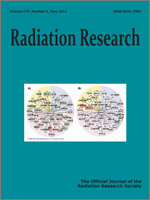Laser accelerated radiotherapy is a potential cancer treatment with proton and carbon-ion beams that is currently under development. Ultra-fast high-energy laser pulses will accelerate ion beams that deliver their dose to a patient in a “pulsed mode” that is expected to differ from conventional irradiation by increasing the dose delivery rate to a tissue voxel by approximately 8 orders of magnitude. In two independently performed experiments at the ion microprobe SNAKE of the 14 MV Munich tandem accelerator, AL cells were exposed either to protons with 1-ns pulse durations or to protons applied over 150 ms in continuous irradiation mode. A slightly but consistently lower aberration yield was observed for the pulsed compared to the continuous mode of proton irradiation. This difference was not statistically significant when each aberration type was analyzed separately (P values between 0.61 and 0.85 in experiment I and P values between 0.32 and 0.64 in experiment II). However, excluding the total aberrations, which were not analyzed as independent radiation-induced effects, the mean ratio of the yields of dicentrics, centric rings and excess acentrics scored together showed (with 95% CI) a significant difference of 0.90 (0.81; 0.98) between the pulsed and the continuous irradiation modes. A similar tendency was also determined for the corresponding RBE values relative to 70 kV X rays. Since the different findings for the comparisons of individual chromosome aberration types and combined comparisons could be explained by different sample sizes with the consequence that the individual comparisons had less statistical power to identify a difference, it can be concluded that 20 MeV protons may be slightly less effective in the pulsed mode.
How to translate text using browser tools
25 March 2011
The Effectiveness of 20 MeV Protons at Nanosecond Pulse Lengths in Producing Chromosome Aberrations in Human-Hamster Hybrid Cells
T. E. Schmid,
G. Dollinger,
V. Hable,
C. Greubel,
O. Zlobinskaya,
D. Michalski,
S. Auer,
A. A. Friedl,
E. Schmid,
M. Molls,
B. Röper
ACCESS THE FULL ARTICLE

Radiation Research
Vol. 175 • No. 6
June 2011
Vol. 175 • No. 6
June 2011




